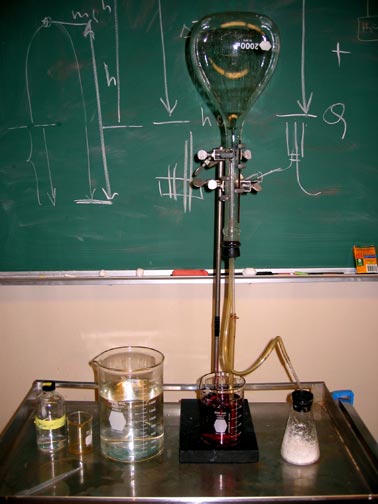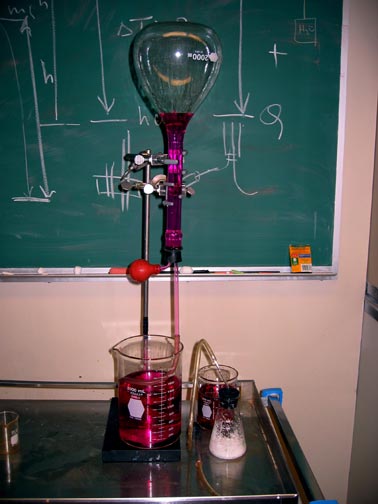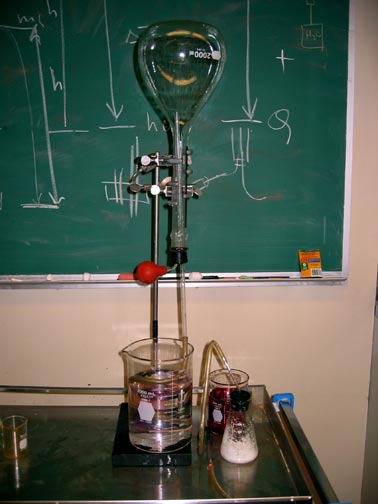The spontaneous dissolution of ammonia gas in liquid water
 The driving force to spontaneously dissolve ammonia gas in water is made to do useful work.
The driving force to spontaneously dissolve ammonia gas in water is made to do useful work.
Ingredients: ammonium nitrate, potassium hydroxide, phenolphthalein, glass beakers, large volumetric flask, two-hole rubber stopper, glass tubing, rubber tubing, rubber bulb
Procedure: A complete recipe follows.
1. Prepare ammonia gas through the reaction of solid ammonium chloride with potassium hydroxide.
2. Capture ammonia gas in inverted flask and seal.
3. Add phenolphthalein indicator to water in beaker reservoir.
4. Insert glass tubing connecting flask containing ammonia to water reservoir.
5. Inject a bit of water into ammonia containing flask using rubber bulb.
6. Observe spontaneous dissolution of ammonia gas in water.
Understanding: The dissolution of ammonia gas in water dramatically demonstrates the nature of a spontaneous chemical reaction
NH3(g) → NH3(aq)
The first step in preparing the reaction is the creation of ammonia gas. Using our knowledge of the chemistry of acids and bases, it is a simple matter to "cook up" some ammonia gas using a common neutralization reactionNH4Cl(s) + KOH(s) → NH3(g) + K+(aq) + Cl-(aq) + H2O(l)
The solid reactants are mixed together and the reaction proceeds spontaneously. At room temperature, the reaction is gradual.The large inverted volumetric flask has a two-hole rubber stopper. One of the glass tubes is connected to a rubber tube that leads to the water reservoir. The second tube is connected to the erlenmeyer flask containing the ammonia-producing salt mixture. A modest quantity of reactants can be used to produce ammonia gas over the course of an hour.
As the ammonia gas enters and is captured in the inverted flask, bubbles will begin to leave the rubber hose in the water reservoir. The ammonia gas is lighter than air, and it will rise to the top of the inverted flask and displace the air. In short order, the bubbles will be bubbles of ammonia gas that cause the water reservoir to turn pink, indicating that the solution is basic and that the flask is filled with ammonia gas.

 The ammonia-producing flask can be removed and replaced by the rubber bulb containing a bit of water. To begin the spontaneous reaction of the dissolution of ammonia gas, just squeeze the bulb! The small bit of water that enters the flask absorbs ammonia gas. The dissolution of ammonia gas in the squirt of water reduces the quantity of ammonia gas in the flask, lowering the pressure inside the flask. And what happens then? Water is drawn up the rubber tube from the reservoir, creating a streaming fountain of pink water that fills the inverted flask!
The ammonia-producing flask can be removed and replaced by the rubber bulb containing a bit of water. To begin the spontaneous reaction of the dissolution of ammonia gas, just squeeze the bulb! The small bit of water that enters the flask absorbs ammonia gas. The dissolution of ammonia gas in the squirt of water reduces the quantity of ammonia gas in the flask, lowering the pressure inside the flask. And what happens then? Water is drawn up the rubber tube from the reservoir, creating a streaming fountain of pink water that fills the inverted flask!
The process is spontaneous and irreversible. What is the principal driving force in this reaction? The entropy of the system would appear to decrease. The entropy of the reactant water and ammonia gas is greater than that of the product dissolved ammonia in water. It must be that the energy of the system also decreases.
We can understand why that is so by thinking of the reaction at the level of atoms and molecules. Recall the Lewis electron dot structure of the ammonia molecule. The ammonia molecules are trigonal pyramidal in shape, and tetrahedral in geometry, with the corners of the tetrahedron being formed by three hydrogen atoms and a lone pair of electrons. The asymmetric distribution of electrons, combined with the difference in electronegativity between the more electronegative nitrogen and more electropositive hydrogens, leads to a substantial dipole moment in the ammonia molecule, 1.5D. For similar reasons, the water molecule has a substantial dipole moment of 1.8D.
The intermolecular attractions between the polar ammonia molecules and polar water molecules are substantial. That leads to a strong driving force to decrease the energy of the solution by dissolving the ammonia gas in water. While the free energy of the reaction system decreases in this spontaneous reaction, the overall energy of the surroundings increases as a positive amount of work is done in raising the water from the beaker into the volumetric flask.
Quantitative determination of the free energy of reaction
Question: Using data for the standard state heats of formation and absolute entropies of the reactants and products, compute the molar changes in enthalpy, ΔHo, entropy, ΔSo, and Gibbs free energy, ΔGo, for the ammonia fountain reaction.You can check your answers here.
Using your result, determine the ratio of ammonia molecules to water molecules in the saturated solution. Does your result make sense? Why might your result be only an approximation to the actual solubility of ammonia in water?
You can check your answers here.
Now suppose that the lowering of the free energy of the reaction system is used to do work in raising the water from the beaker into the volumetric flask. The work done would equal -ΔG = mgh, where m is the mass of water, g the gravitational acceleration, and h the height the water is raised. Assume that the reaction goes to equilibrium. Compute the maximum height that the water could be raised to complete the dissolution reaction.
You can check your answers here.
Computing the solubility of ammonia in water
Question:
Using the result for the standard state molar change in Gibbs free energy, ΔGo, for the ammonia fountain reaction, compute the equilibrium constant for the dissolution of ammonia gas in water.
Heavy lifting with the ammonia fountain
Question:
Suppose that your volumetric flask contains 1.0 L of ammonia gas at 1.0 atm of pressure.
What is the maximum amount of water that would be used to dissolve the ammonia gas to reach the equilibrium saturated solution? What is the change in free energy in that reaction?
Assume that your computed values of the equilibrium constant and solubility of the reaction of ammonia gas in water are accurate.